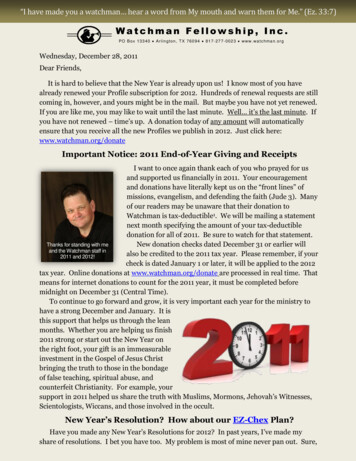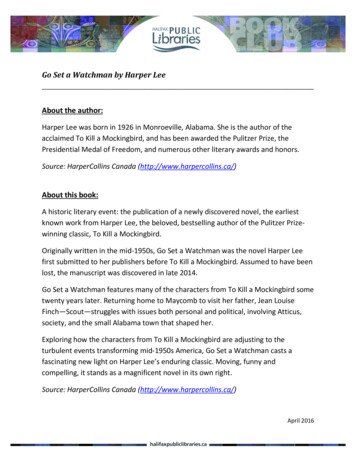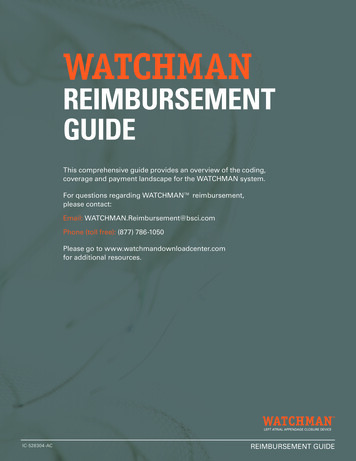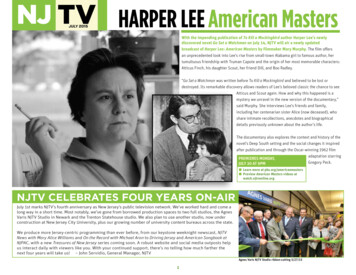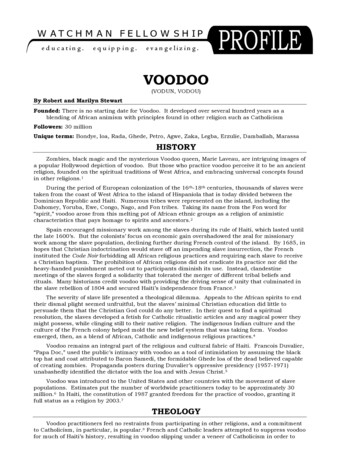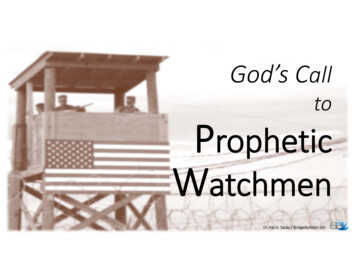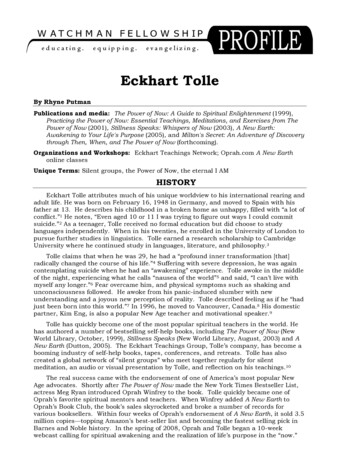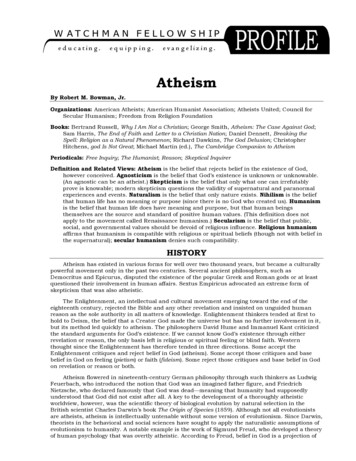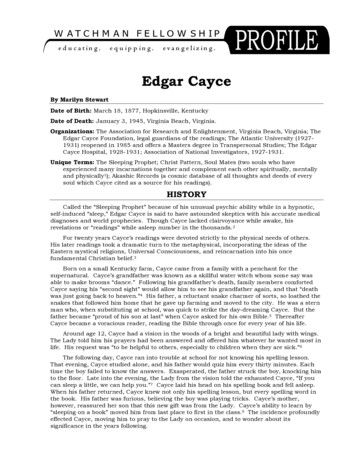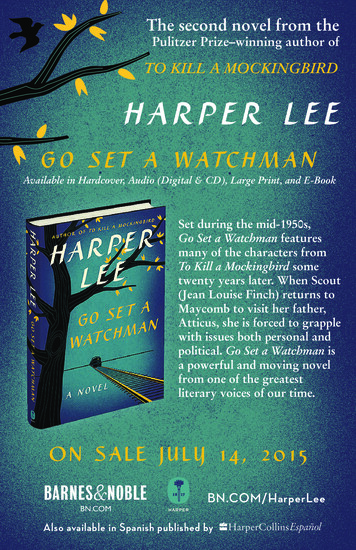
Transcription
The second novel from thePulitzer Prize–winning author ofTO KILL A MOCKINGBIRDHARPER LEEGO SET A WATCHMANAvailable in Hardcover, Audio (Digital & CD), Large Print, and E-BookSet during the mid-1950s,Go Set a Watchman featuresmany of the characters fromTo Kill a Mockingbird sometwenty years later. When Scout(Jean Louise Finch) returns toMaycomb to visit her father,Atticus, she is forced to grapplewith issues both personal andpolitical. Go Set a Watchman isa powerful and moving novelfrom one of the greatestliterary voices of our time.O N S A LE J U LY 1 4, 201 5BN.COM/HarperLeeAlso available in Spanish published by
DISCUSSIONGUIDE TOBN.COM/HarperLee
ABOUT THE BOOKWith gentle beauty and unwavering honesty, Harper Lee takes readers backto the Deep South of the 1930s to illuminate a close-knit small Alabamatown steeped in prejudice, violence, and hypocrisy, the quiet heroism of oneman who struggles for justice in an unjust world, and two young siblings—Scout and Jem Finch—who try to make sense of the irrationality of adultattitudes toward race and class.General Discussion Quest ions1. How does Harper Lee introduce the novel’s major issues of race and class inthe novel? In addition to its social commentary, the novel is also a coming-of-agestory and a tale about childhood memories. How does Harper Lee combine both?2. The book is narrated by Scout looking back to her childhood self between theages of six and nine. How does a narrator influence how a story is told? If Jemwere telling the story, how might it compare to Scout’s version? What if it weretold from an adult’s point of view—from that of Atticus or their neighbor MissClaudia? What kind of a story would Boo or Calpurnia tell?3. Describe Scout, Jem, and their friend Dill. Would you say they are ordinarychildren? If not, what sets them apart from other children? How does being raisedby a single father affect who they are and how they are growing up? What roledoes their housekeeper, Calpurnia, play in their lives?4. What do the adult women in Scout’s life—Calpurnia, Aunt Alexandra, MissMaudie, and even Mrs. Dubose—teach her about being a lady? How does shecontend with others’ expectations of her because of her gender? Are there fewerstrictures on young girls today?5.How do Scout and Jem change over the course of the novel? Are these changesinevitable, or are they shaped by the people around them and the events they areboth witness to and participants in?6.How do Scout and Jem view their father, Atticus? How does the townregard him? What do they learn about their father over the course of the novel?What lessons does he teach his children both directly and indirectly about life,community, duty, decency, and courage?
7.What draws the children to the Radley place? What are their perceptions ofthe Radley family, and especially the mysterious Boo? What hints does HarperLee give us about Boo Radley’s character and how do they contrast with what thechildren believe about him?8.Scout explains, “The misery of that house began many years before Jemand I were born. The Radleys, welcome anywhere in town, kept to themselves,a predilection unforgivable in Maycomb.” Why does she call their behavior a“predilection” and why was it unforgivable? Why do people value privacy? Why doothers often not trust people who choose not to be sociable or socialize?9. Jem tells Scout that there are four kinds of folks in Maycomb County, “ourkind of folks don’t like the Cunninghams, the Cunninghams don’t like the Ewells,and the Ewells hate and despise the colored folks.” Is this a good description ofMaycomb? Does it describe American society itself during the 1930s? What aboutour society today? Why does Scout see everyone as “folks” without divisions?10.How do Scout and Jem learn about the Tom Robinson case? Why does Atticusdefend Tom? What does Scout understand about race when we first meet her andwhat does she learn as the story unfolds? What about Jem?11.One of the most famous lines in literature comes from To Kill a Mockingbird.“Shoot all the bluejays you want, if you can hit ’em, but remember it’s a sin to kill amockingbird.” Explain Atticus’s meaning. Who is the “mockingbird” in the novel?Is it an allusion to the notion of innocence itself?12. Would children be allowed to witness such a trial today? What do thechildren discover about their town, their father, and themselves by attending thetrial? Are adults today too protective of children? What are they trying to protectthem from—and what happens when those children grow up and become adultsthemselves? How does the trial and its aftermath affect Jem and Scout? Today,high-profile trials can often be viewed on TV or online —what impact does thishave on children and our society?13.What role does the setting play in the story? What would have beendifferent had the story taken place outside of a small Southern town? Racialissues still occur in our society today—what impact does location/setting playin relation to these issues?14. Librarians across America voted To Kill a Mockingbird the best novel of thetwentieth century, yet the book is continuously challenged and often banned byschools and communities. What makes the novel so important and so divisive?What does the novel say about America in the recent past? What insights andlessons does it hold for us today?
One of the most beloved novels of all time, To Kill a Mockingbird hasbeen a perennial favorite of readers for more than half a century. Manyfans have revisited this novel after their first reading to experienceagain the beauty and power of Harper Lee’s novel.Discussion Quest ions for Re-Readers1.How old were you the first time you read To Kill a Mockingbird? What wasyour reaction to the book then? How does this reading compare with yourprevious experience? Why did you choose to reread the novel?2.What did you discover with this rereading? Do the characters and the plotstand the test of time? What stands out for you in the novel on your most recentreading?3.What makes the book so beloved by so many readers? If you loved the bookthe first (or previous) time you read it, do you feel the same way now and why?4.Do you remember what you learned about yourself and the world the firsttime you read To Kill a Mockingbird? How have you changed since the first timeyou read the book? Have those changes influenced your opinion of the novel andits characters?5.To Kill a Mockingbird is set during the 1930s and was published in 1960 inthe midst of events that would lead to the passage of the Civil Rights bill. Howdid America change in the intervening years between the book’s setting, itspublication, and today? How have racial and class attitudes evolved over the pastfifty years? Is the book relevant to our world today?6.Did rereading inspire you to revisit your own memories from childhood orhelp you view them in a different way?7.Harper Lee interweaves social commentary about politics, class, and racewith a coming-of-age story and a portrait of small town Southern life during theDepression. Is she successful at smoothly integrating all three elements? How doall three strands work together to create a story that is sweet, tragic, funny, anddeeply serious?8.What lessons can a new generation of readers discover from reading To Kill aMockingbird? What did you take away from reading the book again?
At the heart of To Kill a Mockingbird is a family, Atticus Finchand his children, Scout and Jem. While the novel examines difficultthemes, it is also a story of growing up and discovering the beautyand sometimes painful truths of our world. Harper Lee carefullyexplores innocence, injustice, race, class, and prejudice through theobservations and experiences of a young sister and brother, makingthese difficult issues vivid and clear for all ages to understand.1.Discussion Quest ions for FamiliesTo Kill a Mockingbird is a story of a family and of growing up. Describe Scoutand Jem. Do they get along well? How do their childhoods compare to thoseof children today? What do they learn by being on their own, free from adultsupervision?2.Are there limits placed on Scout because she is a girl? What are those limits?3.How do Scout and Jem view their father, Atticus? How does the town regardhim? Is he a good man and a good role model? What lessons does he teach hischildren about life, community, duty, decency, and courage?4.Atticus tells Scout that you can’t truly understand another person until youstand in his shoes. What does standing in another person’s shoes teach us abouthis or her life? What are some other lessons that Atticus imparts to his children?5.Why does Atticus defend Tom Robinson? He tells Scout, “Tom Robinson’s caseis something that goes to the essence of a man’s conscience.” What is he tellingher? What does “the essence of a man’s conscience” mean?6.What is Calpurnia’s relationship with the family like? Do the Finches seeCalpurnia as more than the help? How do the Finches treat black people? Whatabout the poor? Why does Scout ask Atticus if they are poor? Why does having adifferent skin color or not having money change some people’s ideas about who aperson is?7.Why did Boo Radley and the Radley’s house fascinate Scout, Jem, and Dill?How do the adults behave toward the Radleys? Why did Boo watch over Jemand Scout? In saving the children from their attacker, did Boo do a bad thing?When she meets him for the first time, why does Scout address him as Mr. Arthurinstead of Boo? Why do you think the children never saw him again after thatnight? Do you think he continued to watch over them?
Two years after the novel was published, To Kill a Mockingbirddebuted on the big screen. The critically acclaimed film was nominatedfor eight Academy Awards and won three, and is on the American FilmInstitute’s list of the greatest American movies of all time.Discussion Quest ions forPage & Sc reen Comparison1. How does the film version of To Kill a Mockingbird compare to the novel?What did the filmmakers keep and what did they change?2.What challenges do you think filmmakers face in adapting a book to the bigscreen? Can they remain truly faithful in the retelling using a different medium?3. Can a film ever capture the depth of a book? What does the film version offeraudiences beyond the book?4. Gregory Peck won the Academy Award for Best Actor for his performance asAtticus Finch. Which actors would you cast today if you were making the film?5.The movie poster for To Kill a Mockingbird includes a burst warning that it isnot suitable for children. Do you think most parents today would let their childrenwatch the film? If you have children or hope to, would you allow your children towatch it?6.In its review of the film, the New York Times praised the movie, yet said, “forall the picture’s feeling for children, it doesn’t tell us very much of how they feel.”Do you agree with this criticism? Are Scout’s and Jem’s feelings made clear in thebook? How does a filmmaker capture or evoke “feeling”?7.The late Roger Ebert’s review begins, “To Kill a Mockingbird is a time capsule,preserving hopes and sentiments from a kinder, gentler, more naive America.”Do you think the America portrayed in the book and the movie is “kinder andgentler”? How would you describe this time period?8. The film was released in 1963, in what is considered to be the defining yearof the modern Civil Rights Movement in which major events, including theMarch on Washington took place. Do you think the movie helped to influenceits audience’s views of race and injustice? What impact does popular culture—fictional movies and novels—have on peoples’ attitudes and beliefs? Think aboutrecent films that have stirred controversy. What makes them “divisive”?
A B OU T T HE AU T H O RHarper Lee was born in 1926 in Monroeville,Alabama. She attended Huntingdon Collegeand studied law at the University of Alabama.She is the author of two novels, To Kill aMockingbird and Go Set a Watchman. HarperLee has been awarded numerous literaryawards, including the Pulitzer Prize and thePresidential Medal of Freedom.Suggestions for Further ReadingBooks About Harper Lee & To Kill A MockingbirdHarper Lee’s “To Kill a Mockingbird”—Harold BloomScout, Atticus & Boo: A Celebration of “To Kill a Mockingbird”—Mary McDonnough MurphyMockingbird: A Portrait of Harper Lee—Charles J. ShieldsNonfiction on Related TopicsComing-of-Age ClassicsTo the Mountaintop—Stewart BurnsThe Eyes of Willie McGee—Alex HeardDevil in the Grove—Gilbert KingI Have A Dream—Martin Luther King Jr.A Testament of Hope—Martin Luther King Jr.Marshalling Justice—Michael G. LongStrange Fruit—David MargolickEyes on the Struggle—James McGrath MorrisLet the Trumpet Sound—Stephen B. OatesI Never Had It Made—Jackie RobinsonAmerican Tapestry—Rachel L. Swarns*Sounder—William ArmstrongRed Sky at Morning—Richard Bradford*A Tree Grows in Brooklyn—Betty Smith*Black Boy—Richard WrightBestselling Fiction from the Same EraDust Tracks on a Road—Zora Neale HurstonUp the Down Staircase (1965)—Bel Kaufman*Peyton Place (1956)—Grace Metalious*Tropic of Cancer (1961)—Henry A. MillerThe Group (1963)—Mary McCarthy*Lolita (1958)—Vladimir NabokovDr. Zhivago (1958)—Boris PasternakAtlas Shrugged (1957)—Ayn RandBonjour Tristesse (1955)—Francoise SaganFranny and Zooey (1961)—J. D. SalingerThe Man (1964)—Irving WallaceFiction with Similar ThemesWish You Well—David BaldacciRuby—Cynthia BondThe Chaneysville Incident—David BradleyCrazy in Alabama—Mark ChildressPeace Like a River—Leif EngerA Lesson Before Dying—Ernest J. GainesA Time to Kill—John GrishamSnow Falling on Cedars—David Guterson*Their Eyes Were Watching God—Zora Neale HurstonMudbound—Hillary JordanThe Secret Life of Bees—Sue Monk KiddThe Heart Is a Lonely Hunter—Carson McCullersCry, The Beloved Country—Alan PatonPresumed Innocent—Scott Turrow*The Color Purple—Alice Walker*Native Son—Richard Wright*To Kill A Mockingbird has been banned many times over the years. Asterisk denotes other banned books
Set during the mid-1950s, Go Set a Watchman features many of the characters from To Kill a Mockingbird some twenty years later. When Scout (Jean Louise Finch) returns to Maycomb to visit her father, Atticus, she is forced to grapple with issues both personal and political. Go Set a Watchman
